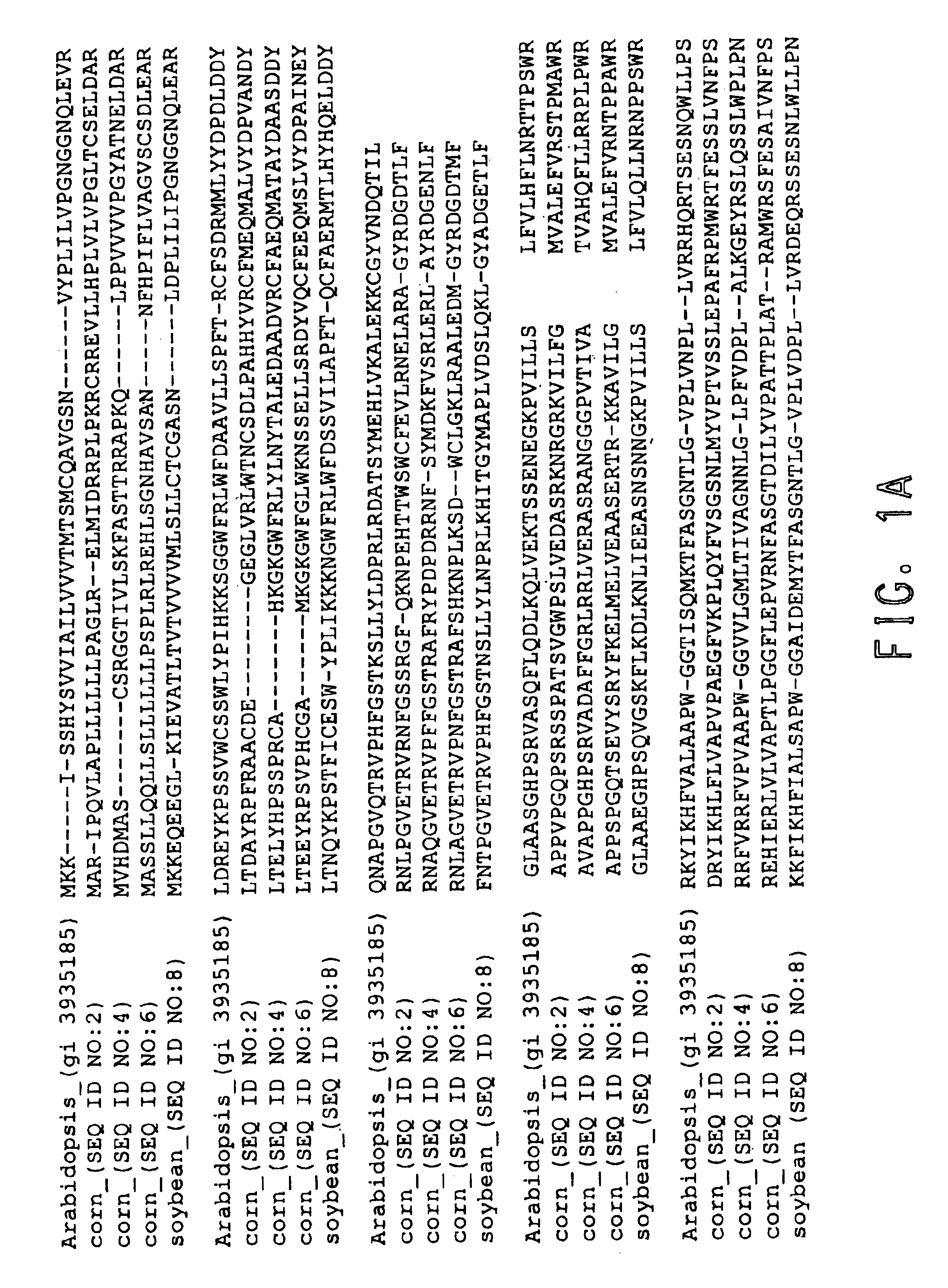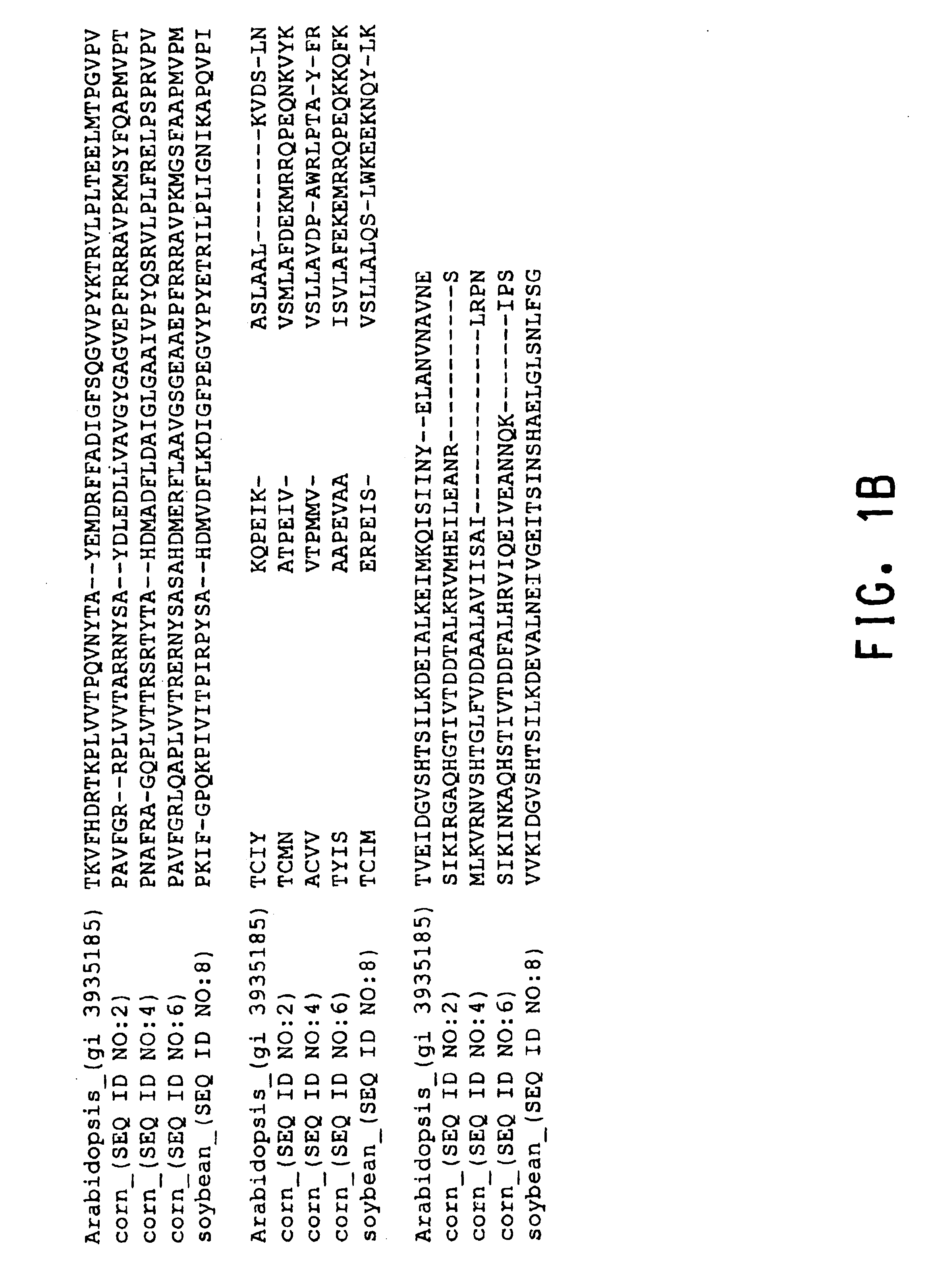Plan lecithin: cholesterol acyltransferases
a technology of cholesterol acyltransferase and plan lecithin, which is applied in the field of plant molecular biology, can solve the problems of complex combination of plant membrane sterols, and achieve the effect of inhibiting activity
- Summary
- Abstract
- Description
- Claims
- Application Information
AI Technical Summary
Benefits of technology
Problems solved by technology
Method used
Image
Examples
example 1
Composition of cDNA Libraries: Isolation and Sequencing of cDNA Clones
[0068]cDNA libraries representing mRNAs from various corn and soybean tissues were prepared. The characteristics of the libraries are described below.
[0069]
TABLE 2cDNA Libraries from Corn and SoybeanLibraryTissueClonecbn10Corn Developing Kernel 10 Dayscbn10.pk0052.g10After Pollinationcbn2Corn Developing Kernel Two Dayscbn2.pk0017.h4After Pollinationp0016Corn Embryo 13 Days After Pollinationp0016.ctsbo30rp0018Corn Ear Shootp0018.chstj36rcen3nCorn Endosperm 20 Dayscen3n.pk0141.f2:fisAfter Pollination*cep1cCorn (Zea mays L.) pollinatedcep1c.pk001.f7:fis(25 hrs after pollination,48-72 after emergence) earschpc24Corn (MBS847) 8 Day Old Shootchpc24.pk0001.c1Treated 24 Hours WithPDO Herbicide MK593**s12Soybean Two-Week-Olds12.pk0015.e8:fisDeveloping Seedlings TreatedWith 2.5 ppm chlorimuron*This library was normalized essentially as described in U.S. Pat. No. 5,482,845, incorporated herein by reference. **Application of ...
example 2
Identification of cDNA Clones
[0071]cDNA clones encoding plant lecithin:cholesterol acyltransferases were identified by conducting BLAST (Basic Local Alignment Search Tool; Altschul et al. (1993) J. Mol. Biol. 215:403-410) searches for similarity to sequences contained in the BLAST “nr” database (comprising all non-redundant GenBank CDS translations, sequences derived from the 3-dimensional structure Brookhaven Protein Data Bank, the last major release of the SWISS-PROT protein sequence database, EMBL, and DDBJ databases). The cDNA sequences obtained in Example 1 were analyzed for similarity to all publicly available DNA sequences contained in the “nr” database using the BLASTN algorithm provided by the National Center for Biotechnology Information (NCBI). The DNA sequences were translated in all reading frames and compared for similarity to all publicly available protein sequences contained in the “nr” database using the BLASTX algorithm (Gish and States (1993) Nat. Genet. 3:266-272...
example 3
Characterization of cDNA Clones Encoding Lecithin:Cholesterol Acyltransferases
[0072]The BLASTX search using the nucleotide sequences from clones cep1c.pk001.f7 and s12.pk0015.e8 and the nucleotide sequences from the contig assembled of clones chpc24.pk0001.c1, cbn2.pk0017.h4, cbn10.pk0052.g10, p0016.ctsbo30r and p0018.chstj36r revealed similarity of the proteins encoded by the cDNAs to lecithin:cholesterol acyltransferase from Homo sapiens (NCBI gi Accession No. 998999) and from rattus norvegicus (NCBI gi Accession No. 418623). The BLAST results for each of these sequences are shown in Table 3:
[0073]
TABLE 3BLAST Results for Clones Encoding Polypeptides Homologousto Lecithin:Cholesterol AcyltransferasesBlast pLog ScoreCloneStatus98999418623cep1c.pk001.f7EST16.4013.40Contig of:Contig12.1014.00chpc24.pk0001.c1cbn2.pk0017.h4cbn10.pk0052.g10p0016.ctsbo30rp0018.chstj36rs12.pk0015.e8EST44.0042.05
[0074]The sequence of a portion of the cDNA insert from clone cep1c.pk001.f7 is shown in SEQ ID...
PUM
| Property | Measurement | Unit |
|---|---|---|
| temperature | aaaaa | aaaaa |
| temperature | aaaaa | aaaaa |
| temperature | aaaaa | aaaaa |
Abstract
Description
Claims
Application Information
 Login to View More
Login to View More - R&D
- Intellectual Property
- Life Sciences
- Materials
- Tech Scout
- Unparalleled Data Quality
- Higher Quality Content
- 60% Fewer Hallucinations
Browse by: Latest US Patents, China's latest patents, Technical Efficacy Thesaurus, Application Domain, Technology Topic, Popular Technical Reports.
© 2025 PatSnap. All rights reserved.Legal|Privacy policy|Modern Slavery Act Transparency Statement|Sitemap|About US| Contact US: help@patsnap.com


